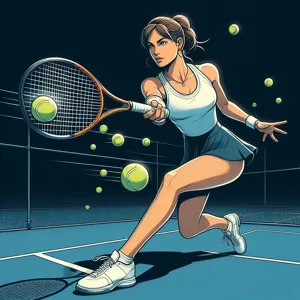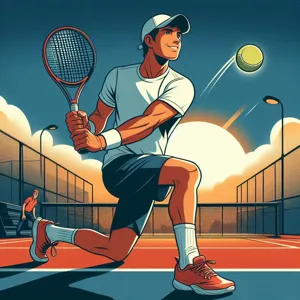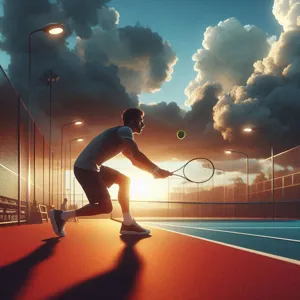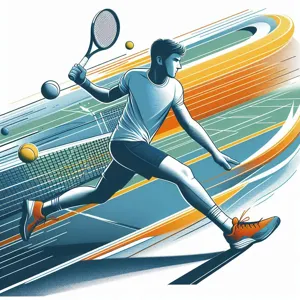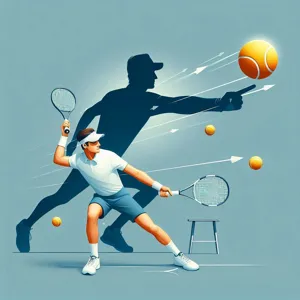Tennis is a sport defined by precision, agility, and strategy, with each stroke offering the potential to outsmart your opponent.
Among the arsenal of shots at a player’s disposal, the drop shot stands out as both an art and a weapon, capable of turning the tide of a match when executed flawlessly. This delicate yet deceptive stroke can catch even the most skilled players off guard, making it a crucial technique to master for any aspiring tennis enthusiast. In this blog post, we will delve into the top techniques for perfecting your drop shot, exploring the nuances of grip, footwork, and timing that will elevate your game. Whether you’re a beginner looking to add variety to your play or an experienced player seeking to refine your skills, our comprehensive guide will provide you with the insights and strategies needed to impress on the court and keep your opponents guessing. Get ready to take your tennis game to the next level as we unlock the secrets of mastering the drop shot!
1. Introduction to the Drop Shot in Tennis
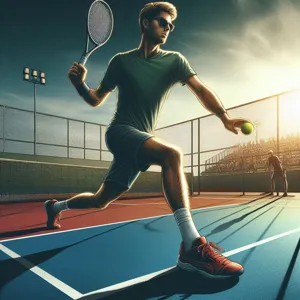
The drop shot is a subtle yet powerful weapon in the arsenal of any tennis player. It’s a shot that, when executed correctly, can leave your opponent scrambling and out of position, creating opportunities for you to take control of the point. Unlike a traditional groundstroke or volley, the drop shot is characterized by its delicate touch and strategic placement. It’s the kind of shot that can turn the tide of a match, catching your adversary off guard and forcing them to alter their game plan.
In essence, the drop shot is all about finesse rather than power. It’s executed with a gentle flick of the wrist, sending the ball just over the net and making it fall rapidly on the opponent’s side. The ideal drop shot is one that bounces low, making it challenging for your opponent to reach and return effectively. However, mastering this technique requires more than just a light touch; it demands a keen sense of timing, an understanding of your opponent’s positioning, and the ability to read the flow of the game.
As you delve into the world of drop shots, you’ll discover that they can be particularly effective when your opponent is positioned far behind the baseline or when they’re anticipating a powerful rally. The element of surprise is key, and the more you practice, the more instinctive your drop shots will become. In this guide, we’ll explore essential techniques and strategies to help you refine your drop shot, ensuring that it becomes an integral part of your playing style. Whether you’re a beginner looking to add variety to your game or an experienced player aiming to enhance your tactical prowess, mastering the drop shot will undoubtedly elevate your performance on the court. Let’s dive in and unlock the secrets to perfecting this exquisite stroke!
2. Understanding the Mechanics of a Drop Shot
### 2. Understanding the Mechanics of a Drop Shot
Mastering the drop shot in tennis begins with a thorough understanding of its mechanics. Unlike powerful baseline shots, the drop shot relies on finesse and precision, making it a unique tool in your arsenal. To execute a successful drop shot, you need to focus on several key elements: grip, stance, swing, and follow-through.
**Grip:** Start with a light grip, perhaps a continental grip, which allows for greater touch and control. A relaxed hold prevents over-hitting, enabling you to gently caress the ball over the net rather than drive it.
**Stance:** Position yourself closer to the net, ideally within the service box. A slightly open stance can be beneficial, as it allows for a more natural swing. Your feet should be shoulder-width apart for balance, and your knees slightly bent to prepare for quick movement.
**Swing:** The swing for a drop shot is compact and deliberate. As you prepare to hit, draw your racket back using a short, horizontal motion. The key is to make contact with the ball softly, just before it reaches its peak. This is where finesse comes into play; your goal is to impart just enough backspin to keep the ball from bouncing high. Focus on using your wrist and fingers to guide the ball with a delicate touch, rather than relying on your arms for power.
**Follow-Through:** After making contact, your follow-through should be gentle and upward, helping to carry the ball over the net with a soft arc. Keep your racket face open to ensure that the ball drops just over the net and lands softly in your opponent’s court. The combination of a relaxed grip, precise stance, controlled swing, and delicate follow-through will help you master the drop shot.
Understanding these mechanics will not only enhance your drop shot technique but also improve your overall game. As you practice, pay careful attention to how your body feels during each motion. With dedication and refinement, the drop shot can become a strategic weapon in your tennis game, catching opponents off guard and creating opportunities to dominate the court.
3. When to Use a Drop Shot: Strategic Considerations

The drop shot is a powerful tool in any tennis player’s arsenal, but knowing when to deploy it can make all the difference between winning a point and losing it. Strategic considerations come into play as you assess your opponent’s positioning, physical condition, and playing style.
First and foremost, timing is crucial. The ideal moment to execute a drop shot often arises when your opponent is deep behind the baseline, perhaps having just hit a powerful groundstroke. By quickly transitioning to a drop shot, you can catch them off guard, forcing them to sprint forward and disrupt their rhythm. Observing your opponent’s footwork is key; if they struggle with quick lateral movements or have a tendency to play cautiously, a well-placed drop shot can exploit those weaknesses.
Another strategic consideration is the state of the match. If your opponent is visibly fatigued, a drop shot can be a highly effective tactic to conserve your energy while putting them under pressure. Additionally, integrating drop shots into your game plan can disrupt your opponent’s expectations. Mixing in drop shots with more aggressive groundstrokes can keep your rival guessing, making it harder for them to establish a rhythm.
Furthermore, court conditions play a significant role in the effectiveness of a drop shot. On slower surfaces like clay, a drop shot can turn into a high-risk maneuver, as the ball might not bounce low enough. Conversely, on faster surfaces such as grass or hard courts, the ball can die quickly, making your drop shot harder to retrieve.
Finally, consider your own strengths. If you possess a delicate touch and can execute a soft, precise drop shot, don’t hesitate to use it. However, if finesse isn’t your strong suit, it may be wise to practice this technique extensively before relying on it during critical match moments. By understanding these strategic considerations, you can master the art of the drop shot and elevate your game to new heights, keeping your opponents on their toes and increasing your chances of success on the court.
4. Grip Types: Finding the Right Hold for Your Drop Shot
When it comes to executing the perfect drop shot in tennis, the grip you choose can make all the difference. The grip not only influences the angle of your racket face but also the amount of spin and control you can exert over the ball. Understanding the various grip types is essential in finding the right hold that suits your playing style and enhances your drop shot technique.
### Continental Grip
The continental grip is often touted as the most versatile grip for drop shots. By positioning the base knuckle of your index finger on the second bevel of the racket handle, you create a neutral grip that allows for quick transitions between different types of shots. This grip provides excellent control and enables you to easily slice the ball, imparting the backspin necessary for a successful drop shot. It also allows for a smooth wrist motion, which can add finesse to your shot.
### Eastern Grip
For players who favor a bit more power and spin, the eastern grip can be an excellent choice. This grip positions your hand slightly more underneath the racket, allowing for a more aggressive angle at contact. With the eastern grip, you can generate a sharper trajectory while still achieving that delicate drop shot that barely clears the net. The slight forward tilt of the racket face also helps in maintaining control, essential for placing the ball just out of reach of your opponent.
### Semi-Western Grip
The semi-western grip is another option worth considering, especially for those who are comfortable with generating topspin. This grip allows for a more closed racket face at contact, which can be advantageous when attempting to disguise your shots. While it may take a bit more practice to finesse a drop shot with this grip, the added spin can make your shot even more unpredictable, forcing your opponent to adjust quickly.
### Experimentation
Ultimately, the right grip for your drop shot will depend on your unique playing style and comfort level. It’s essential to experiment with different grips during practice sessions to see which one feels the most intuitive and effective for you. Pay attention to how each grip influences the trajectory, spin, and control of your drop shot. Over time, you’ll develop a feel for what works best, allowing you to master this delicate yet crucial component of your tennis game.
Remember, the drop shot is as much about finesse as it is about strategy; finding the right grip can elevate your game and keep your opponents guessing on the court.
5. Stance and Positioning for Effective Execution
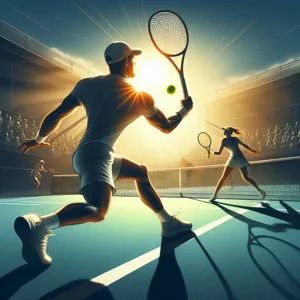
The stance and positioning you adopt while preparing for a drop shot are critical elements that can significantly enhance your execution and effectiveness on the court. To master this finesse shot, begin by focusing on your footwork and body alignment. Ideally, you should position yourself slightly behind the baseline, allowing for a clear view of your opponent’s court and the trajectory of the incoming ball.
As the ball approaches, adopt a balanced stance with your feet shoulder-width apart. This posture not only provides stability but also prepares you to shift your weight smoothly for the shot. Keep your knees slightly bent, which will help you maintain a low center of gravity, essential for quick lateral movements and effective balance.
When it comes to positioning, aim to get as close to the ball as possible while still allowing room for a full swing. Ideally, you want to strike the ball just in front of your body, ensuring that your racket can make contact with a natural motion. This positioning allows you to generate the necessary backspin that makes a drop shot so lethal, causing the ball to barely clear the net and then drop sharply.
Moreover, be mindful of your upper body alignment. Keep your shoulders squared to the net and your racket hand in front, ready to execute the shot. This positioning not only helps in providing better control and precision but also disguises your intent from your opponent, making it harder for them to anticipate your next move.
Practice these fundamentals regularly, and you’ll find that better stance and positioning will lead to more successful drop shots, keeping your opponents guessing and enhancing your overall game strategy. With each drop shot you execute, you’ll not only gain confidence but also elevate your ability to control the pace and rhythm of the match.
6. Footwork Fundamentals: Getting into the Right Position
Footwork fundamentals are the unsung heroes of a successful drop shot in tennis. Mastering your footwork is crucial for positioning yourself optimally to make that delicate return. After all, a beautifully executed drop shot begins long before you make contact with the ball; it starts with your ability to move swiftly and efficiently on the court.
First, you need to develop a solid foundation of agility. This means practicing quick lateral movements, explosive sprints, and precise stops. Imagine you’re on a tightrope—your movements should be balanced and controlled. As your opponent prepares to hit the ball, anticipate the direction and adjust your position accordingly. The key is to remain light on your feet; the more agile you are, the quicker you can react.
When it comes to positioning, the ideal stance is a slight crouch, with your knees bent and feet shoulder-width apart. This not only allows you to spring into action but also helps maintain your balance as you prepare for the shot. As the ball approaches, take small, quick steps to align your body with the trajectory of the ball, ensuring that you are set up to swing with precision.
Don’t underestimate the importance of split stepping, a technique that can dramatically enhance your footwork. By performing a small hop just as your opponent strikes the ball, you put yourself in a state of readiness, allowing for a quick reaction in any direction. This technique gives you the added benefit of being dynamic; it enables you to explode towards the ball, whether it’s coming in low or at an awkward angle.
Finally, practice directional footwork drills that mimic game situations. Set up cones or markers on the court and practice moving to each one as if you’re retrieving a drop shot. The more you incorporate these drills into your routine, the more instinctual your footwork will become during a match.
By honing your footwork fundamentals, you’ll find that your ability to position yourself for a drop shot improves significantly. Not only will you be more effective in executing the shot, but you’ll also start to dictate the pace and flow of the game, keeping your opponents on their toes and enhancing your overall performance on the court.
7. The Importance of Spin in Drop Shots

### 7. The Importance of Spin in Drop Shots
When it comes to executing a successful drop shot, spin is your secret weapon. The right amount of spin can drastically alter the trajectory and bounce of the ball, making it more challenging for your opponent to react promptly. Understanding how to manipulate spin not only adds an extra layer of finesse to your drop shots but also enhances your overall game strategy.
First and foremost, topspin can be a game-changer. When you impart topspin to your drop shot, the ball tends to dip quickly after crossing the net, making it land closer to the opponent’s baseline. This sudden drop forces your opponent to make a split-second decision: sprint forward to retrieve the ball or let it bounce, often resulting in a less controlled return. Practicing this technique ensures that you can execute it with precision under pressure.
Conversely, backspin is equally important in mastering drop shots. By striking the ball underneath and brushing it in a downward motion, you create a backspin that causes the ball to skid off the court on landing. This low bounce can catch your opponent off guard, especially if they’re positioned further back on the court. A well-timed backspin drop shot can be particularly effective when your opponent is expecting a deeper shot, as it disrupts their rhythm and forces them to adjust their positioning.
Incorporating spin into your drop shots can also enhance your ability to disguise your shots. By using similar preparation and body movement for both regular shots and drop shots, you can make it difficult for your opponent to predict your next move. This element of surprise can give you the upper hand, allowing you to dictate the pace of the match and keep your opponent on their toes.
To master the art of spinning drop shots, practice is key. Focus on your grip and racket angle, ensuring you have the right technique to generate the desired spin. Experiment with varying degrees of spin during your training sessions to see how it affects your shot placement and your opponent’s reaction. Over time, you’ll develop a keen sense of how to use spin to your advantage, turning your drop shots into a formidable weapon in your tennis arsenal.
In summary, mastering the spin in drop shots is not just about adding flair to your game; it’s about improving your tactical edge on the court. With practice and attention to detail, you can ensure that your drop shots become a consistent and effective means of outmaneuvering your opponents.
8. Practicing the Drop Shot: Drills and Exercises
Practicing the drop shot requires a blend of precision, touch, and timing, making it essential for players to incorporate targeted drills and exercises into their training regimen. Here are some effective methods to refine your drop shot technique and ensure it becomes a reliable part of your game.
**1. Shadow Swings:** Start by practicing your drop shot motion without a ball. Stand at the baseline and visualize your target, focusing on your footwork and racket positioning. Make exaggerated motions that emphasize the delicate touch needed for a successful drop shot. This exercise helps you develop muscle memory and instills confidence in your stroke.
**2. Target Practice:** Position cones or targets just over the net on the opposite side of the court, ideally within the service box. With a partner or a ball machine, practice hitting drop shots aimed at those targets. Adjust your distance from the net to challenge yourself; start closer and gradually move back as you become more comfortable with your control and accuracy.
**3. Drop Shot and Volley Combo:** This drill helps integrate the drop shot into your overall gameplay. Begin at the baseline and hit a series of groundstrokes with your partner. After a few exchanges, call out “drop shot” and execute one, immediately following it up by moving to the net for a volley. This exercise not only sharpens your drop shot but also prepares you for the quick transition required to finish points effectively.
**4. Reaction Training:** Enlist a partner to stand at the net while you practice drop shots from the baseline. Your partner should react to your drop shots by rushing forward to retrieve them. This drill simulates match conditions, allowing you to gauge the effectiveness of your drop shot under pressure while also improving your opponent’s anticipation and response time.
**5. Incorporating Spin:** To elevate your drop shot game, practice adding backspin to your shot. Start by hitting drop shots with no spin, then gradually incorporate topspin and slice. Experimenting with different spins will keep your opponents guessing and create opportunities for you to surprise them with a perfectly executed drop shot.
By consistently incorporating these drills into your practice sessions, you’ll develop the finesse and strategic thinking needed to master the drop shot. Over time, this once-difficult maneuver will become a powerful weapon in your tennis arsenal, allowing you to dictate the pace of the game and keep your opponents on their toes.
9. Analyzing Opponent’s Positioning for Better Drop Shots
When it comes to executing a successful drop shot, understanding your opponent’s positioning can be the difference between a well-placed winner and a missed opportunity. Observing where your opponent stands on the court not only informs your decision-making but also enhances your tactical approach to the game.
Start by paying attention to their stance and movement. If your opponent is positioned deep behind the baseline, they may be anticipating a powerful groundstroke. This is your cue to surprise them with a delicate drop shot. A well-timed drop shot can exploit their momentum, forcing them to sprint forward and shift gears, which can be both physically and mentally taxing.
On the other hand, if your opponent is standing close to the net, it may be wise to reconsider using a drop shot as they will likely have the advantage to intercept it quickly. Instead, focus on placing your shots deeper into the court or using a different tactic that can throw them off balance.
Additionally, consider their footwork and reaction times. A player who struggles with quick lateral movements is prime for a drop shot, especially when they’ve just executed a powerful stroke that leaves them momentarily off-balance. Watch for those fleeting moments when they are out of position; that’s your window of opportunity to make them chase down a soft, deftly placed ball.
Finally, practice reading your opponent’s patterns. Do they tend to gravitate toward a particular side of the court? Are they more comfortable hitting from the baseline or approaching the net? By analyzing these tendencies, you can set up your drop shots strategically, not just as a random shot, but as a calculated move designed to exploit their weaknesses.
Mastering the drop shot isn’t just about finesse; it’s about strategy. By keenly observing your opponent’s positioning and adjusting your tactics accordingly, you’ll not only improve your drop shot execution but also elevate your overall game on the court.
10. Common Mistakes to Avoid with Drop Shots
The drop shot is a delicate and strategic move that can quickly shift the momentum of a match when executed correctly. However, it can easily backfire if not approached with precision and care. Here are some common mistakes to avoid that can help you master this finesse-filled stroke.
First and foremost, **timing is everything**. One of the most frequent errors players make is attempting a drop shot too late in the rally. This often leads to a poorly executed shot that can be easily intercepted by an opponent who is already anticipating a power stroke. Instead, focus on reading your opponent’s position and commit to the drop shot when they are far from the net, ensuring they have to scramble to reach the ball.
Another pitfall is **lacking variety** in your drop shots. Using the same technique repeatedly can make your shots predictable, allowing your opponent to anticipate and counter your moves. To keep them guessing, mix up your drop shots with different spins, angles, and pace. This unpredictability will make it harder for your opponent to settle into a rhythm.
Additionally, many players underestimate the importance of **court positioning**. A common mistake is executing a drop shot from too far behind the baseline. Ideally, you should be close to the net to increase your chances of hitting a successful drop shot. This positioning not only shortens the distance the ball has to travel but also allows you to follow up quickly if your opponent manages to return it.
Finally, beware of **overthinking the shot**. While it’s essential to have a strategy, getting too caught up in your head can lead to hesitancy or overcompensation, causing you to mishit the ball. Trust in your training and instincts, and let your muscle memory take over when the moment arrives.
By being mindful of these common pitfalls, you can enhance your drop shot technique, making it a powerful weapon in your tennis arsenal. Remember, practice makes perfect, so dedicate time to refine this skill and watch as your returns improve dramatically.
11. Incorporating Drop Shots into Your Overall Game Strategy
Incorporating drop shots into your overall game strategy can elevate your performance on the court, transforming you from a player who simply rallies to a strategic competitor who keeps opponents guessing. The beauty of the drop shot lies not just in its execution but in its timing and placement. To seamlessly integrate drop shots into your match play, consider the following techniques.
First and foremost, understanding your opponent’s positioning is crucial. A well-timed drop shot can be particularly effective when your opponent is deep behind the baseline, giving you the opportunity to exploit their distance from the net. By observing their movement and anticipating when they are out of position, you can surprise them with a delicate touch that forces them to scramble forward.
Next, practice is key. Work on your drop shot during practice sessions until it becomes a reliable part of your repertoire. Focus on achieving the right amount of backspin to keep the ball low, making it more challenging for your opponent to return. Experiment with different angles and heights to make your drop shots unpredictable—varying the speed and trajectory will keep your adversary on their toes.
Additionally, consider the psychological aspect of using drop shots. They can disrupt your opponent’s rhythm and strategy, leading to frustration and unforced errors. As you incorporate drop shots into your game, be mindful of the mental edge it can provide. A well-executed drop shot not only showcases your finesse but also signals to your opponent that you are a versatile player capable of changing tactics at a moment’s notice.
Finally, use drop shots as a strategic tool in conjunction with your other shots. For instance, following up a powerful groundstroke with a sudden drop shot can create an effective contrast, catching your opponent off-guard. The key is to blend drop shots seamlessly with your overall strategy, ensuring they enhance rather than disrupt your flow of play.
By incorporating drop shots thoughtfully into your game, you will not only improve your returns but also develop a more dynamic and unpredictable playing style that can lead to greater success on the court. Embrace the art of the drop shot, and watch as your opponents struggle to keep up with your evolving tactics.
12. Mental Aspects: Staying Composed During Crucial Moments
In the high-stakes environment of competitive tennis, mastering the drop shot isn’t just about perfecting your technique; it’s also about maintaining your mental composure during critical moments. The pressure can be immense, with every point feeling like a turning point in the match. In these moments, your ability to stay calm and focused can make all the difference in executing a successful drop shot.
One effective strategy is to develop a pre-shot routine that you follow consistently, regardless of the match situation. This routine serves as a mental anchor, helping to ground you and keep your mind from spiraling into anxiety. Whether it’s taking a deep breath, visualizing the shot, or simply bouncing the ball a few times, finding a ritual that resonates with you can bring a sense of familiarity and control.
Additionally, it’s crucial to recognize and embrace the pressure rather than shy away from it. Many players struggle during tense moments because they fear making a mistake. Instead of thinking about what could go wrong, shift your focus to what you can control: your technique, your timing, and your strategy. Visualize the drop shot landing perfectly just over the net, and let that image guide your actions.
Another key aspect of mental composure is managing your emotions. Celebrating small successes, such as a well-executed drop shot in practice, can foster a positive mindset. Conversely, when things don’t go as planned, allow yourself to feel the frustration, but don’t let it linger. Acknowledge the slip, learn from it, and promptly refocus on the next point.
Finally, practice mindfulness techniques, such as meditation or breathing exercises, off the court to enhance your mental resilience. By training your mind to stay present and focused, you’ll be better equipped to handle the pressures of the game. Remember, tennis is as much a mental game as it is a physical one. By honing these mental aspects, you’ll find that not only do your drop shots improve, but your overall performance on the court becomes more consistent and composed during those crucial moments.
13. Watching the Pros: Learning from Top Players
One of the most effective ways to elevate your drop shot game is by studying the professionals. Watching top players in action offers invaluable insights into not just the technique, but also the strategic thinking behind their shots. Pay close attention to how they position themselves on the court before executing a drop shot. Notice their footwork—great players like Roger Federer and Ashleigh Barty often make it seem effortless, gliding into position to strike the ball just perfectly.
Moreover, observe the variety in their drop shots. Some players opt for a delicate touch that barely clears the net, while others deliver a more aggressive angle, sending the ball skimming just over the tape. Take note of the scenarios in which they choose to deploy the drop shot—these moments can teach you when it’s most effective to catch your opponent off guard.
It can also be beneficial to analyze their body language and shot selection. Watch how they read their opponents, anticipating movements and positioning themselves strategically to maximize their advantage. You’ll learn to see the court from a different perspective, helping you to identify those split-second opportunities when a drop shot could turn the tide in your favor.
To further enhance your learning experience, consider watching match replays or instructional videos that break down their techniques. Many professional players share tips and tricks on their social media platforms, providing a behind-the-scenes look at their training regimens and shot techniques. Incorporating what you observe from the pros into your own practice will not only refine your drop shot, but also deepen your understanding of the game as a whole. By immersing yourself in the world of professional tennis, you’ll find inspiration and motivation to master your returns and keep improving your skills on the court.
14. Recap: Key Takeaways for Mastering the Drop Shot
As we wrap up our exploration of the drop shot, let’s crystallize the essential techniques and strategies that will elevate your game and enhance your ability to execute this delicate maneuver with confidence and precision.
1. **Understanding Timing**: Mastering the drop shot begins with impeccable timing. Watch your opponent’s positioning carefully; a well-timed drop shot should catch them off guard, ideally when they are deep in the court. Timing not only affects the effectiveness of the shot but also allows you to blend it seamlessly into your overall strategy.
2. **Grip and Preparation**: Use the continental grip for versatility. It allows for a smooth transition between different types of shots, enabling you to disguise your intentions. Always be ready to react, keeping your feet light and your knees slightly bent to spring into action.
3. **Touch and Feel**: The drop shot is all about finesse, so practice developing a soft touch. Use drills that focus on hitting the ball lightly over the net, incorporating various spins to keep your opponent guessing. Remember, the goal is not just to get the ball over the net, but to place it where your opponent least expects it.
4. **Court Awareness**: Cultivate an understanding of the court’s dimensions and your opponent’s weaknesses. A well-placed drop shot can exploit an opponent’s movement and positioning, leading to easy points. Use your observations to decide when and where to deploy the drop shot effectively.
5. **Practice, Practice, Practice**: Like all tennis shots, the drop shot requires consistent practice. Incorporate it into your training sessions, focusing on accuracy and placement. Pair with a partner or coach to simulate match conditions and receive feedback on your technique.
By integrating these key takeaways into your training regimen, you can transform your drop shot from a mere tactic into a formidable weapon on the court. Remember, the drop shot is not just about the action itself; it’s about the strategy behind it. With patience and practice, you’ll not only master this elegant shot but also keep your opponents on their toes, making every match an exciting challenge. Now, get out there and start dropping those shots like a pro!
15. Conclusion: Elevating Your Game with the Perfect Drop Shot
In the world of tennis, the drop shot is more than just a strategic play; it’s an art form that can elevate your game and leave your opponents scrambling. As we’ve explored throughout this guide, mastering the drop shot requires a blend of finesse, timing, and keen awareness of your opponent’s positioning. It’s not merely about getting the ball over the net; it’s about executing a shot that challenges your rival’s footwork and forces them into a defensive stance.
As you refine your technique, remember that practice is key. Spend time on the court perfecting your grip, footwork, and follow-through. Incorporate drills that simulate match situations, allowing you to hone your drop shot under pressure. Additionally, watching professional players can provide valuable insights—notice how they utilize the drop shot to disrupt their opponent’s rhythm and create opportunities for winning points.
Ultimately, the perfect drop shot can be a game-changer, turning the tide in your favor when executed at the right moment. It’s a shot that combines strategy and skill, rewarding those who dare to master it. So, go ahead and integrate this technique into your play. With dedication and practice, you’ll not only enhance your returns but also add a powerful weapon to your tennis arsenal—one that will keep your opponents guessing and elevate your overall game to new heights. Embrace the challenge, and let your drop shot become a signature aspect of your playing style.
In conclusion, mastering the drop shot can significantly elevate your tennis game, transforming your returns into strategic tools that keep your opponents guessing. By incorporating the techniques discussed in this post—such as the importance of timing, the right grip, and practicing your finesse shots—you’ll not only enhance your skill set but also gain a competitive edge on the court. Remember, consistency and practice are key; the more you refine your drop shot, the more effective it will become in your matches. So, grab your racquet, head to the practice courts, and start implementing these strategies. With dedication and effort, you’ll soon be executing flawless drop shots that leave your opponents scrambling and your game thriving. Happy playing!










